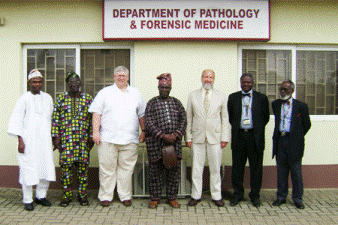Natural Resources, School of

Karl Reinhard Publications
Document Type
Article
Date of this Version
12-2008
Citation
Published in HOMO - Journal of Comparative Human Biology 59:6 (December 20, 2008), pp. 405–427; doi:10.1016/j.jchb.2008.04.005
Abstract
The contact of inland and coastal prehistoric groups in Brazil is believed to have been restricted to regions with no geographical barrier, as is the case in the Ribeira de Iguape valley. The inland osteological collection from the riverine shellmound Moraes (5800–4500 BP) represents a unique opportunity to test this assumption for this region. Despite cultural similarities between riverine and coastal shellmounds, important ecological and site distribution differences are expected to impact on lifestyle. The purpose of this study is thus to document and interpret health and lifestyle indicators in Moraes in comparison to coastal shellmound groups. Specifically we test if the rare evidence of fish and mollusk remains in the riverine shellmound led to (a) higher caries rates and (b) lower auditory exostosis frequency and (c) if the small size of the riverine shellmound translates into reduced demographic density and thus rarity of communicable infectious diseases. Of the three hypotheses, (a) was confirmed, (b) was rejected and (c) was partly rejected. Bioanthropological similarities between Moraes and coastal shellmounds include auditory exostoses with equally high frequencies; significantly more frequent osteoarthritis in upper than in lower limbs; cranial and dental morphological affinities and low frequencies of violent trauma. However, there are also important differences: Moraes subsisted on a much broader protein diet and consumed more cariogenic food, but showed a stature even shorter than coastal groups. Thus, despite the contact also suggested by treponematoses in both site types, there was enough time for the people at the riverine site to adapt to local conditions.
O contato de grupos pré-históricos brasileiros interioranos e costeiros é tido como restrito a regiões sem barreiras geográficas, como é o caso do vale do Ribeira de Iguape. A coleção osteológica interiorana do sambaqui fluvial Moraes (5800– 4500 pYB) representa uma oportunidade única para testar tal afirmação para a região sudeste. Embora haja similaridades culturais entre sambaquis fluviais e costeiros, espera-se que as importantes diferenças ecológicas e de padrão de assentamento influenciariam a saúde. No presente estudo, objetiva-se documentar e interpretar indicadores de saúde e estilo de vida dos habitants de Moraes, em comparação com sambaquieiros da costa. Mais especificamente investigamos se as raras evidências faunísticas de peixe e molusco no sambaqui fluvial associamse a (a) frequencias de cáries mais elevadas, e (b) proporções menores de exostose auditiva e se (c) as diminutas dimensões do sítio fluvial correspondem a baixa densidade demográfica e consequentemente baixos índices de doenças infecciosas transmissíveis. Confirmou-se (a), enquanto (b) foi inteiramente, e (c) parcialmente, rejeitada. Semelhanças bioantropológicas entre habitantes de Moraes e sambaquieiros da costa incluem exostese auditiva em frequências igualmente altas; significativamente mais osteoartrose em membros superiores que inferiores; afinidades morfológicas dentárias e cranianas, assim como baixas frequências de traumatismos violentos. Entretanto, também foram constatadas diferenças importantes: os indivíduos de Moraes, de estatura ainda inferior a de sambaquieriros da costa, alimentavam-se de uma dieta mais cariogência, sendo o aporte proteico mais diversificado. Assim, apesar do contato, sugerido inclusive através da presença de treponematose em ambos os tipos de sítio, houve tempo suficiente para o grupo fluvial adaptar-se a condições locais.
Included in
Archaeological Anthropology Commons, Ecology and Evolutionary Biology Commons, Environmental Public Health Commons, Other Public Health Commons, Parasitology Commons


Comments
Copyright © 2008 Elsevier GmbH. Used by permission.